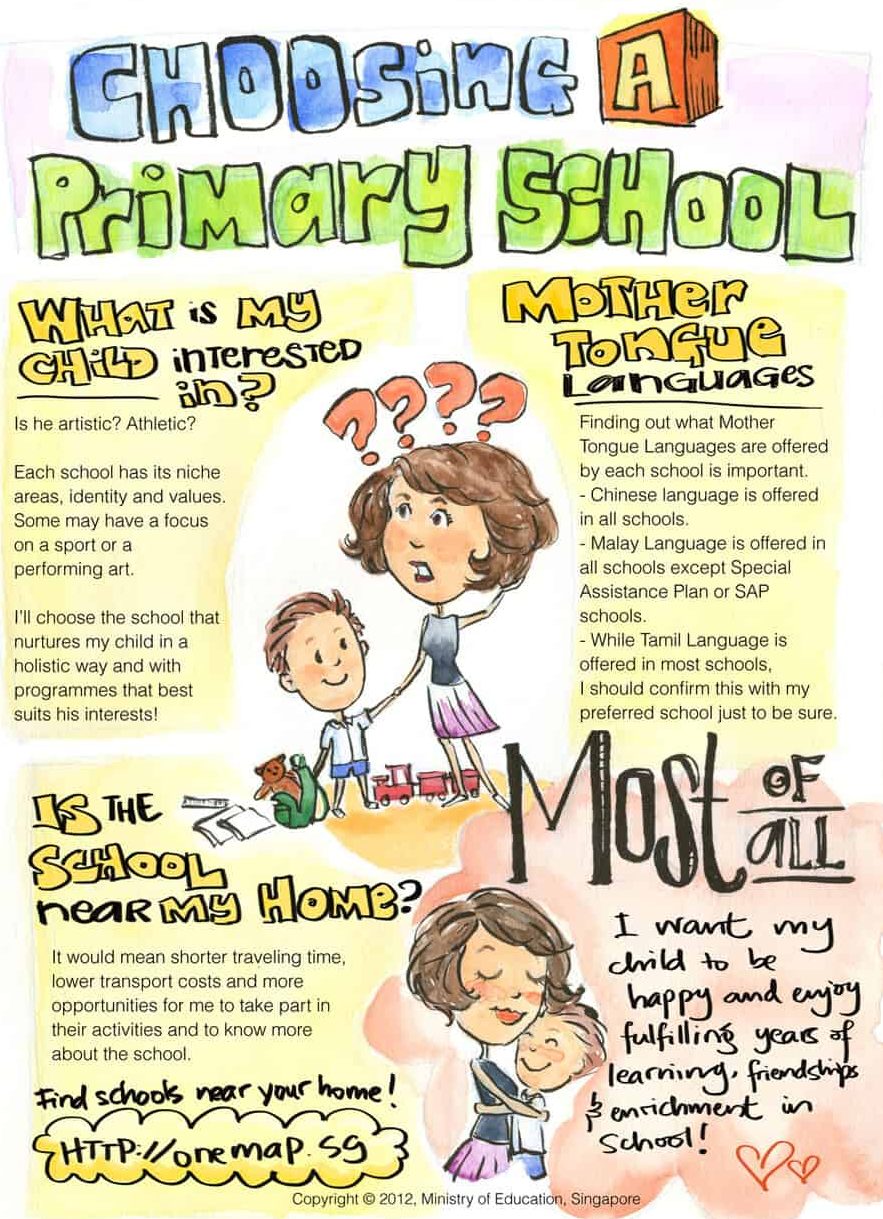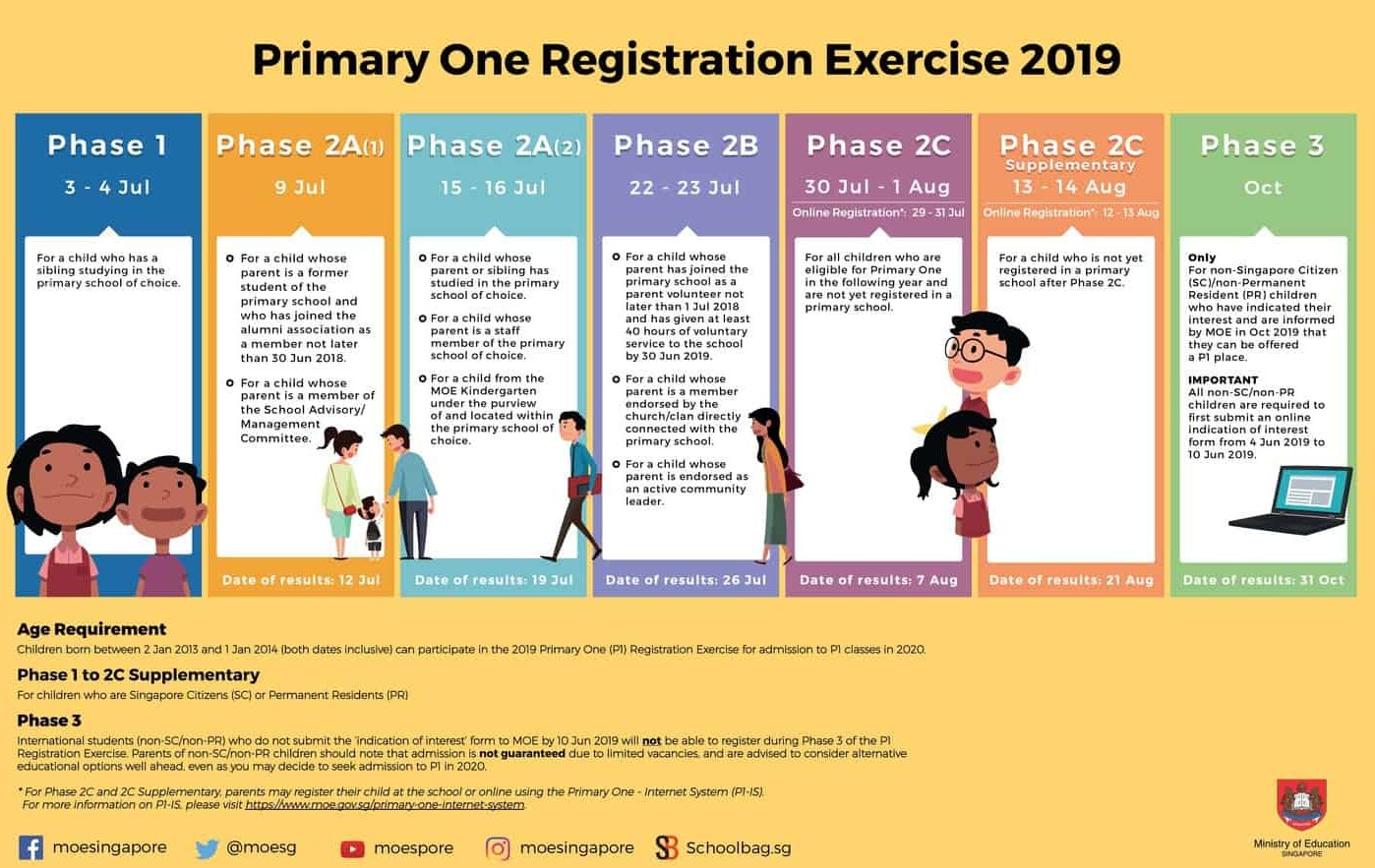Choosing A Primary School: Frequently Asked Questions By Parents
Submitted by KiasuEditor

It’s Open House season once again for many primary schools in Singapore, all the way till late July. Visit Schoolbag.sg for an updated list of primary schools holding open house events.
Still undecided about what school to choose for your child, even after attending the open house? Singapore’s Ministry of Education (MOE) advises parents to consider five factors when deciding on a school:
 [Source: MOE]
[Source: MOE]
- Your child’s abilities and interests: Is your child already exhibiting a talent that you intend to develop? Will your child thrive in a more competitive school, or a more relaxed environment? The MOE’s School Finder allows you to search for schools that offer a particular co-curricular activity, or schools that have special electives and programmes.
- The school’s culture: What is the school best known for? What are the school’s core values, and how are these values encouraged in class? Does the school have a strong alumni or parent support network?
- The ease of getting to school: How long does it take to get to school by car/school bus, or public transport? Will the school bus fares be within your budget? Use the School Finder to search for schools near your home, or within a specified area.
- Mother tongue: What second language will your child be taking? Do you want your child to take Higher Chinese, Higher Malay, or Higher Tamil? Use the School Finder to narrow down schools based on your second language preferences.
- Special needs: Does your child have any special learning needs? Is the school equipped to nurture your child? Use the School Finder to search for schools that support hearing loss and other physical challenges.
Below, we look at some questions that have been asked by our KSP community leading up to the Primary 1 registration process, to offer some insights for first-timer parents:
 [Source: MOE] Click on image to enlarge
[Source: MOE] Click on image to enlarge
Should I choose a nearby school or a preferred one that is further away?
Some parents strongly recommend choosing a nearby school. “It’s hard to judge primary schools through isolated incidents, hearsay, or a few visits,” says a parent. “Fortunately, all primary schools are good schools.”
Many parents are also willing to consider schools that are 45 minutes to an hour away by public transport, if other criteria are met. In fact, with new public transport developments such as the opening of stations along the new Thomson-East Coast MRT line, many schools will be more accessible in the near future.
Don’t forget to check on the MOE website if the school you’re considering is currently at a holding location, or will be relocating due to upgrading works. “Some parents may not like the disruption and inconvenience,” says a parent.
What is a good school culture?
This is for you, the parent, to define. What’s most important to you? Is it:
- the school’s definition of “success” and its academic and co-curricular track record
- student life (school facilities, enrichment activities, and other opportunities for growth)
- the general behaviour of students
- the calibre of teachers
- the principal’s experience and reputation
- the core values of the school
- the strength of the school’s alumni network
Being clear about what you value in a school can help you greatly in your decision-making process.
If you want to be precise, you could even assign a weightage to each criterion, in order to help you rank your shortlisted schools. (See an example of how to create your own simple school ranking system, and get more tips on what you should be looking out for when you research or visit schools.)
Should I choose a popular school, or a less well-known one?
Is a high-achieving school (“big pond”) the best for our children? Or would they fare better in a less competitive school (“small pond”)? You need to be honest with yourself about where you think your child can thrive. (Read our article on the research that has been conducted on “big pond” and “small pond” environments, and how they affect low-ability, middle-ability, and high-ability students.)
A commonly held misconception is that the teachers in popular primary schools are better. “Every school has its share of good and not-so-good teachers,” says a KSP member. “[Unpleasant incidents with teachers] also happen in ‘branded’ schools.”
However, what you may encounter in popular schools is that students tend to have more access to tutors and enrichment classes. In other words, they would have entered primary school with good language and math skills, making it harder for students who have not enjoyed the same access in their preschool years to keep up.
Should I choose a school that is known for setting tough papers?
“I’ve been downloading many school’s past-year papers for my son to practise, and I can tell the Special Assistance Plan (SAP) schools tend to set their exam papers at a much higher difficulty compared to the non-SAP schools,” observes a parent.
Whether or not this is true, it is relatively easy to buy or download school papers these days — and schools themselves often give their students papers from other schools to practise on.
More importantly, as Singapore moves away from the “regurgitation” style of answering exam questions, what matters is whether the school is testing your child on skills that will be valuable in the long run.
Should I choose a school that my child’s younger siblings can also get into?
This is a common dilemma for parents who have children of both sexes.
“There are pros and cons of both angles — convenience versus customization. Some think that customization is better,” says a parent. “You need to think carefully if you can handle the kids being in different schools.”
“I chose different schools for both my children, a girl and a boy,” reveals a mother. “I sent my daughter to my primary school (all-girls) for a hassle-free registration process. For my son, who is five years younger, we balloted at an all-boys school where we had religious affiliation, and we were successful. Both children used to take the school bus unless they had after-school activities; my daughter is able to travel independently now. From what I can see, both schools suit my children well, and there hasn’t been much juggling required on my part.”
Should I choose an all-girls or all-boys school?
“One thing I have noticed is that boys who have grown up with sisters are generally more gentle-natured… they have been trained not to play too rough,” says a mother. “While such boys are good for society and make very good husbands in future, they may not adapt well when thrown into an all-boys school. The boisterous camaraderie and general roughhousing that is common among boys when they play together may shock some milder parents and kids who have not encountered this before.”
That said, it’s impossible to predict how a child will fit into any school. As a parent, all you can do is to choose a school that you believe is good for your child, and be ready to support your child if issues should come up. (Read about dealing with school bullying here.)
“I’ve heard about relational bullying being common in girls’ schools, and have experienced it myself. However, my daughter has had a smooth primary school journey at her all-girls school,” says a mother. “My son is reserved when he’s not around family, and he took about a year to get comfortable in the rowdy atmosphere of his all-boys school. He still needs to learn how to assert himself, but he is often placed together with some of the ‘naughtier’ boys in class, as the form teacher finds that he has a calming effect on them. I’ve quizzed my son about these boys and I find that he is amused, rather than threatened, by them.”
Should I choose a school with an affiliated secondary school?
There are 27 secondary schools in Singapore with affiliated primary schools, and you can view the list here.
Changes have been announced to the school affiliation system, and they will kick in this year, where 20% of a secondary school’s places must be reserved for students without affiliation priority. (Previously, there was no cap on the number of affiliated students that a school could accept. You can read about how the new system will work on the MOE website.)
What this means is that affiliated entry to a secondary school will now depend on two factors:
- A child meeting the affiliated PSLE (Primary School Leaving Examination) entry score set by the school.
- Whether the demand for places in the affiliated school is lower or higher than 80%.
The affiliation system will be further fine-tuned when the new PSLE scoring system is implemented in 2021.
At this point, it’s hard to predict if affiliated schools will still provide an almost-guaranteed entry for many of its students. But it’s definitely an advantage over not having an affiliation at all.
Still have a question about choosing and evaluating primary schools? Seek advice from the KSP community here. Some of the comments above were excerpted from KSP school discussion threads; they have been lightly edited for length and clarity.